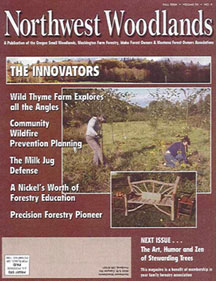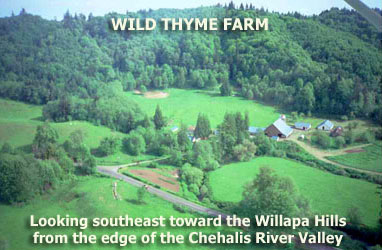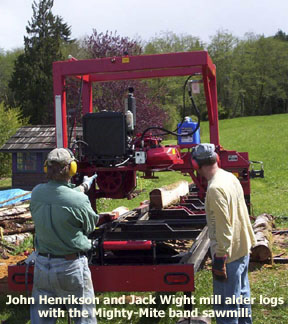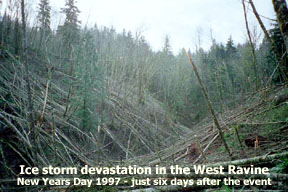











|
|
|

From Character Wood to Silvopasture
Wild Thyme Farm Explores all the Angles
by John Henrikson
 The dramatic evolution of the forestry operation at Wild Thyme Farm near Olympia, WA speaks more to the transformation of the landowners than to the land itself. Acquired in 1987 by three brothers raised on the east coast and most recently from California, we had zero land management experience coupled with the typical “hands-off”, preservationist approach to our new land. Starting with a 100 acre, third-growth, natural regeneration of primarily 17 year-old red alder, we were immediately advised to cut our losses, clear-cut the alder and replant with Douglas-fir, a real timber tree. This option was clearly out of the question for us at the time. So we continued doing nothing, until the great ice storm of 1996 leveled 30 acres of our tall, spindly, un-thinned alder in one day. Like the fires ravaging our overstocked, unmanaged forests all across the west, this was our wake-up call to become very active in managing our forest. The dramatic evolution of the forestry operation at Wild Thyme Farm near Olympia, WA speaks more to the transformation of the landowners than to the land itself. Acquired in 1987 by three brothers raised on the east coast and most recently from California, we had zero land management experience coupled with the typical “hands-off”, preservationist approach to our new land. Starting with a 100 acre, third-growth, natural regeneration of primarily 17 year-old red alder, we were immediately advised to cut our losses, clear-cut the alder and replant with Douglas-fir, a real timber tree. This option was clearly out of the question for us at the time. So we continued doing nothing, until the great ice storm of 1996 leveled 30 acres of our tall, spindly, un-thinned alder in one day. Like the fires ravaging our overstocked, unmanaged forests all across the west, this was our wake-up call to become very active in managing our forest.
Today, eight years later, with a forest management plan in place and 150 acres to tend to, we are producing high-quality, specialty hardwoods in a growing market that currently surpasses Doug-fir in value. We’ve found that defective logs rejected or devalued by the mill frequently have characteristics that increase their value compared to the industry standard, including stain (red-heart), early stages of rot (spalting) and figure (mostly in maple). These off-grade “character” woods sell much faster and command a higher price than normal wood when sold directly to end users such as home builders (for trim), and cabinetry and furniture makers. We are even exploring ways to enhance stain (to go all the way through the wood or in a flame pattern) and spalt (introduce competing fungus to aggressively colonize the wood and create intricate patterns quickly). With figured wood, the key is milling the wood at the proper orientation to expose the most valuable grain pattern, much like cutting a diamond.
 Additionally, we mill oversize items such as slabs for tabletops or benches and long trim pieces that are not produced by the big mills, but frequently sought by specialty woodworkers. Much of our alder is maturing rapidly and soon the harvest will exceed our ability to process and sell it all, so we will send the high-quality logs to the mill to get their premium price and retain the off-grade logs for our specialty value-added processing, capitalizing on a resource that is typically wasted. Having hardwoods at all stages of development, the harvesting should be continuous, even annual, along with occasional extra spurts of production resulting from small stand-replacement cuts. It may not apply as well to conifer forests, but it is feasible for a Northwest hardwood stand to be perpetually harvestable starting at about 30 years. Additionally, we mill oversize items such as slabs for tabletops or benches and long trim pieces that are not produced by the big mills, but frequently sought by specialty woodworkers. Much of our alder is maturing rapidly and soon the harvest will exceed our ability to process and sell it all, so we will send the high-quality logs to the mill to get their premium price and retain the off-grade logs for our specialty value-added processing, capitalizing on a resource that is typically wasted. Having hardwoods at all stages of development, the harvesting should be continuous, even annual, along with occasional extra spurts of production resulting from small stand-replacement cuts. It may not apply as well to conifer forests, but it is feasible for a Northwest hardwood stand to be perpetually harvestable starting at about 30 years.
On the numbers side, we are initially working with a general rule of thumb of harvesting one tree per acre per year to be minimally profitable while furthering stand improvement until the forest reaches maturity. If we can net $1.00 per board foot (with an average sales price of $2.00/bf and harvest/production costs a little less than $1.00/bf), it doesn’t take a very large tree to produce $300 to $500 net income per acre per year. Additionally, by increasing the quality and volume of the timber, combined with value-added processing and creative marketing, even fewer trees need to be harvested to achieve this goal. At some point, the forest will reach its carrying capacity in high value standing timber and continuous harvesting should produce an annual income much higher than during the development stage. Of course, we won’t try to find one tree on every acre to harvest every year, but if we maintain that rate of harvest across the forest as a whole, it should produce a steady income while the value of the standing timber increases.
But the lumber production at Wild Thyme Farm is just one part of our overall vision. We have several other activities that support each other in creating a viable economic model while maintaining the primary vision of the land as sanctuary – a special place for enjoyment and celebration.
 Permaculture and Agroforestry Permaculture and Agroforestry
In the shortest phrase, I would describe permaculture as “productive perennial landscaping”, with the name itself being a combination of “permanent” and “agriculture”. The objective is to create complex, multi-species, multi-story productive landscapes where the individual elements are selected and placed for optimum mutual benefit. It has similarities with many millennia-old indigenous land management practices. When first encountering the grasslands and forests of the Native Americans, the untrained eye would see only a beautiful “wild” landscape, rather than the carefully managed pasture or “food forest” designed for perpetual harvest. With the vastly increased population pressure on our current landscape, permaculture seeks to discover and implement the most healthy and productive human/plant/animal communities, maximizing local inputs of energy and resources while minimizing external costs and maintenance effort.
Wild Thyme Farm has numerous examples of this practice, including riparian habitat restoration, agroforestry (multi-purpose trees grown in a plantation setting for the production of fruit, nuts, roundwood and lumber), silvopasture (integration of grazing animals into established agroforestry plantings) and the aforementioned “food forest”, with hundreds of varieties of fruits, berries, herbs, edible mushrooms and flowers. Much of our designed landscape is at the mature, low-maintenance stage, while other parts are still evolving, requiring occasional timely maintenance. We are also currently converting distressed blackberry and canary reed grass zones into permaculture zones, requiring high initial effort and follow-up maintenance (for the first year or two), but proving remarkably successful. What once took us four or five years to get established (to a low maintenance level) now takes less than 2 years.
 Eco-Tourism and Agro-Tourism Eco-Tourism and Agro-Tourism
As we spruced up the old farm outbuildings to accommodate family and friends, visitors would inquire about renting the facility for their own family reunions, weddings, land-use based workshops and other events. Our landscape had also evolved as a demonstration site for many innovative land management techniques, including permaculture and agroforestry. Coincidentally, eco-tourism and agri-tourism were being touted as a potential new revenue stream for struggling farmers and other landowners. It seemed like a natural for us.
In 2002, we took a test run with the farm as a retreat center / vacation rental. However, after a short stint with exemplary guests and a promising outlook, we could not overcome the time-consuming and costly permitting and regulatory process, not to mention the astronomical insurance premiums. Innovation does not sit well with local, state agencies and insurance companies. They can relate to large, conventional, well-funded developments that can afford to jump through the hoops, but small operators hoping to pursue some creative, mixed-use activity on their land are in for a frustrating and potentially fruitless struggle. It is particularly galling to hear the endless talk about the urgency of supporting small rural communities and diversifying their economy. Even with all the grants and government programs available, we can now see why so little seems to be happening. One is led to believe they will be supported for taking a risk and starting an innovative new land-based business, but the path to reality is strewn with one exasperating barrier after another.
We may revisit the agri/eco-tourism option in the future, but not without a solid business plan and serious financial backing – not an encouraging note to other innovators out there.
Community Participation
With a landscape as complex and multi-faceted as Wild Thyme Farm, the labor cost to maintain it all is worth considering. Currently, the resident owner averages half time (20 hours per week) and the paid employees average between 40 and 60 hours per week (about 1 to 1.5 full time equivalents). In all, it takes the equivalent of about 2 full time employees to handle the forestry and all other land/facility management tasks at the farm. While this may not be a model for profitability (unless the timber harvest achieves the annual return mentioned earlier), a primary objective for the farm landscape is research, development and education, where profitability is not necessarily the goal. However, if the farm can operate as a retreat center, it would be better suited to meet this objective while generating enough profit for further development.
In the meantime, because certain parts of the landscape have achieved a sustained level of productivity, we are experimenting with “leasing” these sections to neighbors and other growers/harvesters for the price of maintaining them according to our management guidelines plus sometimes a small share of the harvest. In this case our overall labor cost is reduced as a “negative-expense” income source. To expand this model, we need to find ways to fine-tune our landscape to be attractive to potential lessees, although not all of the landscape, especially the more ornamental zones, will fit the bill. Good working relationships with neighbors not only builds community, but it enriches the land, something that’s so hard to achieve when we try to do everything ourselves. The events and celebrations hosted by the farm throughout the year highlight this loving relationship with the land.
Advocacy
We have numerous visitors to the farm, especially from the “hands-off” school of forest management. As they rave about the beauty, wildness and health of the forest, I emphasize that it is our active management, including lots of selective thinning, that creates this “classic” forest look and feel. They think it is all natural because it looks that way, and it comes as a revelation to find out that we have removed a lot of trees from the picture. Although we always acknowledge that nature does the “heavy lifting” around here, the well thought out, surgical extraction according to the management plan accelerates the forest towards the mature, balanced stage that everyone’s looking for. What is most remarkable is that we are not working with an old established forest handed down through generations. Aside from tiny remnant stands of 50 to 100 year-old trees, the average age of our forest is about 35 years. This means that creating substantial and productive forests can occur quickly with the most humble and neglected landscapes – we’re not talking about established, controversial “trophy” forests here. Our work towards creating a diverse stand with large, vigorous trees while continuously producing valuable timber is one of many living examples of forest practices that should be widely supported by the environmental community. We need to grow past the management paralysis at the state and federal level using the example of tree farmers across the country. The fear of the chainsaw is deep and unreasonable. I look forward to re-educating the skeptics when they come to visit the fabulous forest at Wild Thyme Farm. After all, I was once in their shoes.
|

